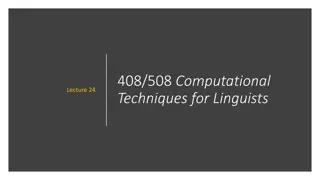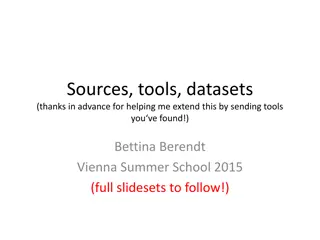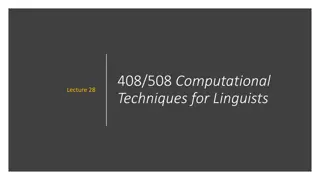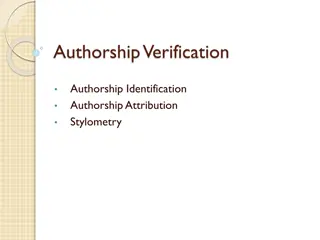Exploring Computational Techniques with NLTK for Linguists
Dive into the world of computational techniques for linguists with NLTK in Lecture 24. Learn about list comprehensions, conditional forms, tokenization, part-of-speech tagging, parsing, chunking, concordance, similarity, common contexts, dispersion plots, and more. Discover where NLTK is installed o
0 views • 22 slides
Exploring Sources, Tools, and Datasets in Text Mining
Discover a plethora of sources, tools, and datasets in text mining through resources shared by Bettina Berendt and references from lectures and publications. Uncover DH-specific tools and powerful NLP tools like Ling Pipe, OpenNLP, Stanford Parser, and NLTK Toolkit for text analysis and processing.
0 views • 17 slides
Understanding Bigrams and Generating Random Text with NLTK
Today's lecture in the Computational Techniques for Linguists course covered the concept of bigrams using NLTK. Bigrams are pairs of words found in text, which are essential for tasks like random text generation. The lecture demonstrated how to work with bigrams, including examples from the NLTK boo
0 views • 19 slides
Authorship Verification and Identification through Stylometry Analysis
Utilizing methods like word frequency clustering and machine learning classifiers, this project aims to verify authorship and determine the writers of various texts by renowned authors such as Charles Dickens, George Eliot, and William Makepeace Thackeray. By analyzing writing samples and employing
0 views • 25 slides
Investigating Bias in Newspaper Articles through Natural Language Processing
The project, mentored by Jason Cho and advised by Professor Eric Meyer, focuses on automatic bias detection in newspaper articles. It involves recognizing similar article topics and detecting bias using tools like OpenNLP and Python NLTK. The endeavor aims to uncover words correlated with bias and a
0 views • 5 slides




